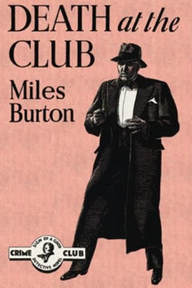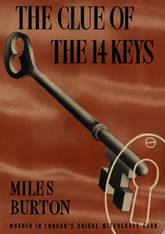
Death at the Club (U.S. title The Clue of the Fourteen Keys, a nod to the number of suspects with access to the scene of the crime) is an agreeable little mystery, although its writing, plotting, and characterization offer little to raise it above the realm of the competent detective yarn. I manage to read intermittently the stories of Cecil John Street, who published dozens and dozens of novels under the names John Rhode and Miles Burton, picking one up after a hiatus of months and sometimes years. When I do, I'm reminded of a few reliably recognizable features. First, Rhode is (usually) scrupulously fair in his fair play plotting, often to the point that the reader can easily get ahead of the investigating detective. So it's interesting here, in Club, that the general why is obvious – Brockman is a scoundrel – but the who is unknown until the final-chapter reveal only because the author leaves the reader in the dark about a character's prior history that provides the motive. It's not an approach that satisfies, but it certainly keeps one guessing until the nicely sustained penultimate chapter, when the trap is sprung.
Next, a sampling of the Rhode/Burton titles shows the work of a writer who placed puzzle first, while literary elements like mood and style and characterization received a lower priority. I make this claim as I think about opportunities that Street never pursues. Thirteen members of a Witchcraft Club is a tantalizing prospect, but there is never, ever a moment when the occult is even fleetingly explored. No character has a comment about pagan blood sacrifice – poor Brockman's throat was slit ear to ear, after all – no description is presented of any spooky memorabilia within the club (could not the police dust skulls for fingerprints?), no mention of supernatural suspicion or voodoo vengeance to explain the violent death, even in passing. Of course, the author's interest lies in the puzzle and clue collecting, but the omission is notable, as is the fact that all club members are also respected representatives of society, including a police commissioner, a doctor, a barrister, a businessman, and an academic. The group could be changed to The Philately Club with almost no story editing required.
Finally, while I enjoy the Rhode and Burton books, the ones I have read rely on suspect and witness interviews for the bulk of the book, and complicating plot developments are sometimes few and far between. (There seems to be quite a lot of Merrion's conversational theorizing and Arnold's arguments to fit his prescribed view of the facts.) In contrast, consider how Agatha Christie propels her stories. Christie enjoys her interview scenes, but her interviewees often have a tone – combative or wistful or bitter or circuitous – that encourages a dramatic tension between characters. She also knows that stakes must be raised and the pot must continue to boil, which is why so often a nosey parlormaid meets her maker around page 140 in a Christie story. In Death at the Club, we do have a suspect who flees, but it is really only in the neatly staged conclusion, where Sir Edric observes the murderer in action, that the tension rises. Then again, the focus is mystery; suspense, when it is used, is ancillary.

"The possibility that a hired assassin might have been employed could be dismissed. Hired assassins had gone out of fashion in recent years."
 RSS Feed
RSS Feed